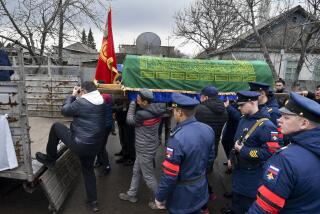In Russia, Boots Made the Old-Fashioned Way
- Share via
KALYAZIN, Russia — For generations, this Volga River town has been known for its valenki -- the felt boots that protect the feet of Russian children and adults from the harsh winter.
The boots were first made by artisans in their homes, then manufactured by workers in the dusty, damp and noisy factory named Red October in honor of the Bolshevik Revolution.
Now, after a dispiriting shutdown in the late 1990s when government contracts dried up, the plant is back in business as part of a Moscow-based company called Biitsa, whose need for cheaper production costs meshed with the Kalyazin workers’ desperate need for jobs.
In return for monthly pay averaging around 5,000 rubles, or $175, some 90 workers take bales of rough wool and beat, steam and shrink it into boots. Their wage is a little more than half the average salary of 9,300 rubles, about $330.
“Of course we’d like bigger salaries,” shop steward Maria Lukyanova said, the wistfulness in her tone suggesting there’s no better pay to be had in the depressed town.
Kalyazin, with a population of 16,000, has lost a lot of young people to Moscow, the magnet for investment and the jobs that go with it some 110 miles away.
It also lost a good bit of its territory to the capital: two-thirds of it was flooded in the 1930s to create a reservoir for Moscow. The bell-tower of the submerged 19th century Nikolayevsky Church pokes from the reservoir as a ghostly reminder.
Yet it’s the town’s economic backwardness that saved the valenki plant, said Vadim Ivanov, the factory’s manager.
“It’s not unimportant that we are located in a small city and the land here costs very little, so there weren’t fights over land or manufacturing sites,” he said. “And since the equipment at the factory is pretty unique -- it cannot be used in other manufacturing -- there was no point in selling it off.”
The plant certainly doesn’t look like its new owners have invested much.
The work of turning out 700 to 900 pairs of boots a day is intense, noisy and grimy.
Dust blankets the machines that sort the rough wool, which comes in wire-bound bales from the former Soviet republics of Uzbekistan and Kazakhstan in Central Asia.
The smell of wet sheep permeates the place. Steam hangs over everything, and the dim light seems to turn every color into some shade of gray. Many of the women standing over the machines wear half-finished valenki to ward off the chill of a wintry day.
A large board hangs on a wall in the entry, announcing: “These employees bring shame to our enterprise.” Today it’s empty, but on other days it displays the names and pictures of workers who are chronically late or drunk on the job.
All the workers get free milk to help compensate for the health effects of working in constant humidity. Those who work directly with the steam machines are entitled to retire five years earlier than usual -- if they can afford to live on a pension even more paltry than their wage.
The equipment is decades old, but Ivanov says they don’t have much problem finding spare parts. Many other valenki plants in Russia have closed, providing a steady source of equipment like the metal shoe trees used to shape the boots.
The plant is trying out new decorations, such as embroidery and appliques, in hopes of interesting new buyers. But it will be a battle to turn valenki into a fashion statement.
Aside from children, street cleaners and policemen, few people wear valenki in Moscow and other big cities. Most favor leather boots for style or cheap synthetic snowboots imported from China.
But come to a small town like Klyazin, or visit Russians in wintertime at their beloved country cottages, and you’ll see the boots everywhere, on young and old alike.
“I know myself that in boots my feet freeze quickly,” said Lukyanova, the shop steward. “Valenki are like little stoves, very warm.”
More to Read
Sign up for Essential California
The most important California stories and recommendations in your inbox every morning.
You may occasionally receive promotional content from the Los Angeles Times.












